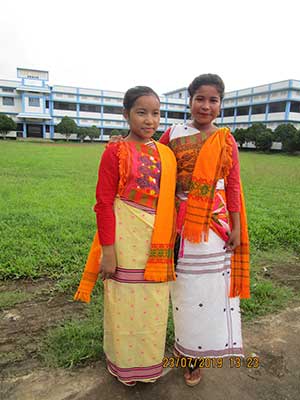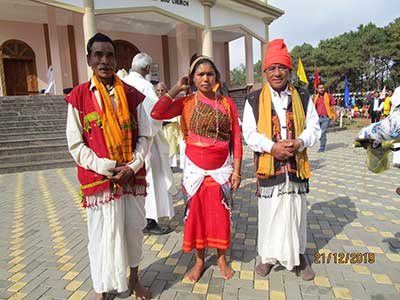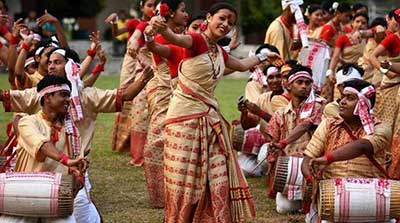
Tiwa or Lalung is an indigenous tribe of the Tibeto-Burman race whose habitats are mainly Assam and Meghalaya. They are also found in Arunachal and Manipur. Literally meaning “the people who were lifted from below”, Lalung is a recognized scheduled tribe in Assam. They prefer to call themselves Tiwa though in the Assamese Buranjis (Assamese Chronicles), Colonial literature and in the Constitution of India, the term Lalung was/is used.

Tiwas are divided into two groups — the Plains Tiwas and Hill Tiwas — each with rather contrasting cultural features. The Plains Tiwas live on the flat lands of the southern bank of the Brahmaputra valley, consisting of Morigaon, Nagaon, Hojai, Kamrup, Sibsagar, Jorhat, Lakhimpur and Dhemaji districts of Assam which may be called Tiwaland (Tiwashong).
Culturally, religiously and linguistically the Plains Tiwas have been hugely influenced by the dominant non-tribal population of the plain. Except in the foothills and in rare villages in the plain, Assamese has become the mother tongue of the vast majority of Plain Tiwas. Even in primary school Assamese is the medium of instruction. Though with specific features, their religion has many elements of Assamese Hinduism.

Plains Tiwas follow the patrilineal system of descent. Their patronymics are not derived from their clan’s names but are common Assamese, and plain Tiwas ethnic surnames are like Manta, Dekaraja, Dewraja, Bordoloi, Konwar, Doloi, Kakoti, Deka, Deory, Bhuyan, etc.
The Hill Tiwas are in the westernmost areas West Karbi Anglong district (Assam) or ‘The Ancient Lalung-Tiwa Hills’ and in the north-eastern corner of Ri-Bhoi district of Meghalaya. A peculiar system of descent exists which may be called ‘ambilineal’. At marriage, usually the husband goes to live in his wife’s family settlement and their children take the name of the mother’s clan. This might be called matrilocality. However, due to the influence of neighbouring patrilineal populations it is not unusual for a woman to live with her husband’s family. In such cases, children’s descent is from the name of the father.
The Tiwa tribe belongs to the Tibeto-Burman language of the Bodo-Garo group. Many words have common roots in Tiwa, Bodo and Garo. Grammatically too these languages are similar. In the Hills, the Tiwas use the Roman script as early foreign missionaries wrote religious and literary books, in that script. The Hill Tiwas follow indigenous religion based on the worship of local deities.

The chief festival of the Tiwas are Three Pisu (Bihu), Borot utsav, Sogra phuja, Wansuwa, Jonbeel Mela, Kabla, Langkhon Phuja, Yangli Phuja, etc. During these festivals two types of songs are sung: Lo Ho La Hai — songs of the ceremony of name-giving, wedding, harvesting, etc., and, Lali Hilali Lai — songs of a marriage ceremony, Karam and other festivals. The tribe has one of the richest reservoirs of folk songs and dances in Assam and Meghalaya.
According to 2011 census, the Tiwa population in India is approximately 371,000. Of these, the vast majority are Plains Tiwas. The population of the Hill Tiwas is estimated at 15,000. The 2011 census says that the total number of Tiwas who speak the Tiwa language is only 34,800. They were recognized as a scheduled tribe by the first Constitution (1950) for the State of Assam. The Lalung of the autonomous districts of Karbi Anglong and Dima Hasao (North Cachar) were not included. It was only in 2002 that the scheduled tribe status was extended to Lalungs of Karbi-Anglong. Tiwas are not a scheduled tribe in Meghalaya.

A microscopic aboriginal tribe faces many challenges. But they have immense potential, as well. A few are listed below:
Literature: Evidently literature is at the initial stage. Fr Michael Balawan, a Tiwa language pioneer, wrote A Tiwa-English and English-Tiwa Dictionary (With Khasi) in 1982 and Tiwa-English Grammar and Translation. Fr U. V. Jose, SDB, too has contributed immensely to Tiwa literature. In 2014, he brought out the much-appreciated Tiwa-English Dictionary. In 2019 the complete Tiwa Bible, mostly translated by him, was released.
Works of well-known poets, writers and novelists may soon be translated into Tiwa with the aim to have Tiwa as a subject at the secondary, higher secondary, college and university level in Assam.

Education: Education is the biggest tool for empowerment, and is absolutely needed for the Tiwa community. As in the case with a mixed population, most of members of the tribe (including students) are multi-lingual. They are fluent in four to five languages, including English. For a higher education Jagiraod is about 60 km. away and Guwahati is less than three hours’ journey. Shillong too is at an affordable distance.
Economics: The Hill Tiwa tribe practises jhum farming. Minor scale rice cultivation is also done. Other crops produced from jhum cultivation are ginger, pumpkins, chillies, maize, etc. Poor road connectivity is a major reason for economic backwardness of the area. Being in the border between Assam and Meghalaya neglect is too apparent.
Political leadership: Though the Plains Tiwas have the Tiwa Autonomous Council since 1995, the Hill Tiwas is too small a group for any political organization. From the community only one is an elected member of the Karbi Anglong Automomous District Council (MAC). For a molecule tribe to survive and be heard, political identity is both a challenge and an opportunity for the Tiwas of the Hills.
For more articles like this, subscribe to the print or digital editions of THE TEENAGER TODAY.
The post Tiwa (Lalung) Tribe appeared first on The Teenager Today magazine.
